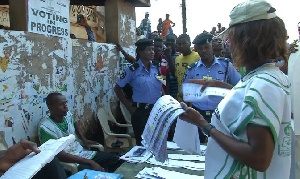? impact on women, children and communities
GNA Feature by Samuel Adadi Akapule
Women in communities in the Talensi District of the Upper East Region would ever remain very grateful to the World Vision Ghana (WVG) “Farmer Managed and Natural Regeneration”(FMNR) Project introduced in the District in 2009. The rate at which women, who commute long distances in search of fuel woods in the bush end up being raped by Fulani herdsmen, has plummeted.
Many of the women in the nine communities where the FMNR is being practised have begun harvesting fuel wood for cooking and fodder for their animals. Medicinal plants that were difficult to find are now available and most of the women who are herbalists are tricking in good profits. The FMNR, to a large extent, has also curbed rural-urban migration, particularly that of women. Women including men in the Yameriga, Tongo-Beo, Yinduri and Wakii , Balungu, Shia, Sepaat, Namolgo and Yagzore communities can now harvest grass to roof their houses which hitherto was difficult since they had to travel far distances in search of the raw materials.
The FMNR involves selecting and pruning stems regenerating from stumps of naturally grown trees on the field to give fewer ones more space to grow. This stimulates faster growth of the trees.
Through capacity building training of the FMNR Project and support, more of the communities in the Talensi District are advancing on their own, in practising the concept and this is greening the environment considerably. The area is fast becoming a forest. Over 200 hectares of land degraded through human activities have been reclaimed in the Talensi District through the FMNR Project.
In a visit to the community by this writer to have a feel on the ground, it was realised that not only women and communities members were enjoying the benefits of the FMNR. Children also in particularly eat the fruits yielded by the Project. It was a delightful spectacle to see a large group of schoolchildren trooping to the FMNR project sites after school hours to consume the fruits they never had access to until now.
Master Samuel Yinkurug, a primary six pupil, said: “After consuming these fruits with my colleagues everyday, I do not feel like taking any more food when I get home. I also get nutrients from the fruits I eat.”
Mrs. Charity Yambil, Chairperson of FMNR in charge of Yameriga, on her part said “there is now abundance of shea and other fruits and this is increasing our incomes. Most of us can now pick enough sheanuts for processing into sheabutter for sale. We no longer walk at dawn and long distances to pick sheanuts which often affects our household chores. Through the FMNR many of us now can pay our children’s school fees on our own. Most us no longer travel to southern parts of the country to do menial jobs like washing of bowls at chop bars and being engaged as head porters. There is also a greater unity within the community as we always work in groups under the FMNR.”
The Chief of Yameriga, Naba Yamdaan-Zembil Longmoare, one of the beneficiary communities, said the intervention introduced by the Talensi World Vision Area Development Programme(ADP) had made a significant impact on not only women and children but the entire communities in the District.
“Thatch, rafters, firewood and medicinal ingredients are starting to save households time and money. The spate of animal thefts has decreased considerably due to local availability of fodder through the project,” he stressed.
According to the chief, previously most of the children in the area had to become shepherds at the expense of their education since they had to shepherd cattle to longer distances to feed. “But now fewer boys are being kept from school to be shepherds due to local availability of fodder. There is also abundance of fruits in the wet seasons due to bushfire suppression. Children eat fruits every day”.
He indicated that animals in the communities are now fatter and healthier than before due to abundance of grass and added that due to the shades and nesting areas created by the FMNR fowls are shielded from hawks. It had also increased the number of hares and partridges leading to the increase amount of protein in human diet .
More shades produced by the FMNR, he noted, had also helped reduced stress, improve mental health and soil quality and yields also improving as a result of improved composting creating volumes of organic fertiliser.
“Leaving crop residue in fields, trees leaf drops, birds’ droppings and animal have increased soil fertility. As tree canopies and grass are sheltering soils, the environment is becoming conducive and thus becoming agro forestry,” he added.
The Talensi ADP Manager of WVG, Mr Norbert Baba Akolbila, said the Forestry Research Institute twice in a year validates the growth of the trees by measuring their growth in terms of height and diameter to determine their growth and said it had revealed that each year they double thrice in terms of height and diameter.
He said his outfit with support from the World Vision Australia supported selected farmers from the District to Burkina Faso to learn more about the technology who then came back and implemented the technology still with the support from World Vision Australia.
According to him the desired goals of the project was to sustainably improve the livelihoods of people in the District, increase income levels, increase the number of households with food all year round.
He stated that farmers adopted sound natural resource management practices, adopted FMNR on forest reserves and farmland, used crop residues as fertiliser and fodder.
The projected also provided information and training to farmers, help them develop local laws to support good environmental management, establish and train community fire-fighting volunteers It also supported in the adoption of supplementary income and resource generation, promotion and training of the farmers for the adoption of fuel-efficient wood stoves.
No wonder when Mr. Peter Weston, from World Vision Australia, came to Ghana last year to evaluate the project he said he was very much impressed about its successes and confirmed that under the project: “Farmers adopt sound natural resource management practices. The about 500 acres of FMNR forest reserves and the half a million new trees created by the FMNR project is very great.”
At a focus groups discussion held last year about the anticipated changes in the next five years results, the farmers and other stakeholders anticipated that there would be more food from trees, the replacement of older shea trees by new ones, more shades, more fuel woods, more rafters, more soils protected and also fertilised by trees and animals residues, more windbreaks, bigger harvests and more incomes among others.
The project implementation also included a lot of cross-cutting development issues including Gender, Environment and Peace-building and Protection and Christian Commitment among others.
The good news is that farmers across the districts in the region are now expressing interest to learn the technology due to the enormous benefits that can be accrued from it. Recently about 60 farmers made up of 30 women and 30 men from the Garu-Tempane District trooped to Talensi District to learn the FMNR from the Talensi ADP of WVG .
Speaking to some of the women after the practical training they indicated that there were excited about the level of development and would adopt the project as soon as they return home.
According to the ADP Manager of the Talensi District, the project would be extended to cover 30 more communities in the Talensi District and would include how to manage composting, conservation and would also introduce new crops such soya beans, new spices of acacia trees piloted in Niger which had edible fruits. It would also introduce Village Saving and Loans Schemes for the communities.
WVG is also replicating the FMNR in the Kassena-Nankana West, Garu Tempane and Bawku West Districts.
It should be pointed out that the brain behind the FMNR is Mr. Tony Rinaudo, an official of World Vision Australia. He is the originator of this model and deserves to be acknowledged and commended for that).
Research has revealed that by contrast, FMNR is very cheap, rapid and replicable without ongoing external or government support. It is very effective and has the capacity of reclaiming large scale of degraded land and forest regeneration, Bio-diversity with the return of wildlife, rate plant species and natural pest predators.
In Niger Republic one of the world’s poorest nations for instance, more than 3 million hectares has been re-vegetated using this method. Also using satellite imagery, researchers at the United States Geological Survey have been able to identify where tree densities and tree cover in Niger have increased over time and where these changes are likely attributable to FMNR. Estimates from high-resolution images acquired during 2003 to 2008 pegged FMNR at nearly 5 million hectares in Niger.
Because of FMNR, farmers in Niger are producing an estimated additional 500,000 tonnes of cereals a year. This additional production covers the requirements of 2.5million people out of a total population of about 15 million in 2009. FMNR also has an indirect impact on food security through tree crop products, which farmers can harvest and sell in local markets. Moreover, despite a near-doubling of the population since 1980, Niger has been able to maintain per capita production of millet and sorghum, which make up more than 90 percent of the typical villager’s diet. Per capita production remained at approximately 285 kilograms between 1980 and 2006.
Researches have also proven that Farmers in the Central Plateau of Burkina Faso have rehabilitated at least 200,000 hectares of land using the techniques. If cereal production increased by an average of 400 kilograms per hectare, conservative estimate-farmers has increased their annual harvest there by 80,000 tonnes or enough to feed about 500,000 people. With these increases, farm households that suffered from food deficits of six months or more during the early-1980s when the FMNR was not then practised have been able to reduce their deficit periods from six months to two or three months, or to zero in some cases.
It is very significant to note that the FMNR techniques adopted by farmers in Burkina Faso and Niger have changed barren agricultural landscapes in those countries into complex agricultural systems with more vegetation and more varied vegetation. In the Central Plateau of Burkina Faso, rehabilitated plots have an average of 126 trees per hectare, compared with 103 trees per hectare on control plots. Moreover, the trees on rehabilitated land are large and represent a wider range of species. The level of water in wells has improved significantly since land rehabilitation started, and farmers have created small vegetable gardens around several wells, adding their incomes and improving nutrition. Increased water recharge appears to result from increases in rehabilitated lands and not from increases in rainfall.
The question now is what can stakeholders especially chiefs, opinion leaders, District Assemblies, Assembly Members Member of Parliament including Government learn from this reliable and simple method of environmental conservation and preservation. In fact, the practice of FMNR have been tried and tested and has proved its reliability more than the conventional forms of tree planting.
The Technology is now available at the doorsteps of the Talensi ADP of WVG and it is very important for stakeholders particularly chiefs, opinion leaders, District Assemblies, Assembly Members Member of Parliament including Government to encourage communities to learn from this reliable and simple method of environmental conservation and preservation. The Forest Commission and the Savannah Accelerated Development Authority (SADA) should go into partnerships with World Vision Ghana to ensure that the technology is adopted by all communities particularly in the three northern regions where environmental degradation is very serious. This would help address the problem of the phenomenon when that is done.
The only challenges of the FMNR are about snakes while pruning, misuse of agricultural chemicals such as “condemn” and fertilizer damaging the soils. Fires originating from neighbours which is often a major problem confronting the project. But with the provision of gloves and wellington boots and the training of fire volunteers and educating people to stop using Condemn the issue would be resolved.
It is conclusive enough by quoting the Chief of Yameriga, Naba Yamdaan-Zembil Longmoare, who said: “For me, when you take away water , the next vital thing is the tree and everybody should as much as possible, plant, nature and protect trees if we want to survive.”
Lets us all embrace the concept to ensure that it helps improves the livelihoods of more women and children and the communities members at large.
samuelakapule@yahoo.com
Opinions of Saturday, 15 June 2013
Columnist: Akapule, Samuel Adadi














